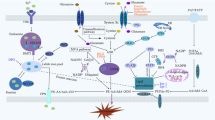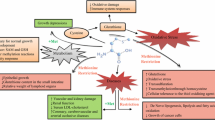Abstract
Dietary fiber fermentation by the colonic bacterial flora produces short-chain fatty acids, acetate, propionate and butyrate. Among them, butyrate is considered to be the major energy substrate for colonocytes and, at least in rats, seems to protect against colonic carcinogenesis. In this study, we examined the effect and the mechanisms of short-chain fatty acids on the activity of phase 2 enzymes. Sodium butyrate increased phase 2 enzyme activities in normal rat small intestine epithelial cells, Glutathione S-transferase and NAD(P)H:quinone oxidoreductase (NQO) in a dose-dependent manner; however, other short-chain fatty acids did not increase them. The mechanism of the induction of phase 2 enzymes with sodium butyrate sodium butyrate, but not other short-chain fatty acids was related to the increase of NF-E2-related factor 2 (Nrf2) nuclear translocation and the decrease in the levels of nuclear fraction p53. Sodium butyrate also caused enhancement of Nrf2 mRNA levels and suppression of p53 mRNA levels. Sodium butyrate enhances the activities of phase 2 enzymes via an increase in the Nrf2 protein levels in the nucleus and a decrease in the mRNA and protein levels of p53.







Similar content being viewed by others
References
Cummings JH, Pomare EW, Branch WJ, Naylor CP, Macfarlane GT (1987) Short chain fatty acids in human large intestine, portal, hepatic and venous blood. Gut 28:1221–1227
Roediger WE (1980) Role of anaerobic bacteria in the metabolic welfare of the colonic mucosa in man. Gut 21:793–798
Scheppach W (1994) Effects of short chain fatty acids on gut morphology and function. Gut 35:S35–S38
Hague A, Manning AM, Hanlon KA, Hart LI, Huschtscha D, Paraskeva C (1993) Sodium butyrate induces apoptosis in human colonic tumour cell lines in a p53-independent pathway: implications for the possible role of dietary fibre in the prevention of large-bowel cancer. Int J Cancer 55:498–505
Wu JT, Archer SY, Hinnebusch B, Meng S, Hodin RA (2001) Transient vs. prolonged histone hyperacetylation: effects on colon cancer cell growth, differentiation, and apoptosis. Am J Physiol Gastrointest Liver Physiol 280:G482–G490
Augeron C, Laboisse CL (1984) Emergence of permanently differentiated cell clones in a human colonic cancer cell line in culture after treatment with sodium butyrate. Cancer Res 44:3961–3969
Ho SB, Yan PS, Dahiya R, Neuschwander-Tetri BA, Basbaum C, Kim YS (1994) Stable differentiation of a human colon adenocarcinoma cell line by sodium butyrate is associated with multidrug resistance. J Cell Physiol 160:213–226
Smith TJ, Piscatelli JJ, Andersen V, Wang HS, Lance P (1996) n-Butyrate induces plasminogen activator inhibitor type 1 messenger RNA in cultured Hep G2 cells. Hepatology 23:866–871
Litvak DA, Evers BM, Hwang KO, Hellmich MR, Ko TC, Townsend CM Jr (1998) Butyrate-induced differentiation of Caco-2 cells is associated with apoptosis and early induction of p21Waf1/Cip1 and p27Kip1. Surgery 124:161–170
Gleave ME, Sato N, Sadar M, Yago V, Bruchovsky N, Sullivan L (1998) Butyrate analogue, isobutyramide, inhibits tumor growth and time to androgen-independent progression in the human prostate LNCaP tumor model. J Cell Biochem 69:271–281
Miyake H, Hara I, Yamanaka K, Gohji K, Arakawa S, Kamidono S (1999) Overexpression of Bcl-2 enhances metastatic potential of human bladder cancer cells. Br J Cancer 79:1651–1656
Burkitt DP (1971) Epidemiology of cancer of the colon and rectum. Cancer 28:3–13
Pool-Zobel B, Veeriah S, Bohmer FD (2005) Modulation of xenobiotic metabolising enzymes by anticarcinogens—focus on glutathione S-transferases and their role as targets of dietary chemoprevention in colorectal carcinogenesis. Mutat Res 591:74–92
Coles B, Ketterer B (1990) The role of glutathione and glutathione transferases in chemical carcinogenesis. Crit Rev Biochem Mol Biol 125:47–70
Hu R, Hebbar V, Kim BR, Chen C, Winnik B, Buckley B, Soteropoulos P, Tolias P, Hart RP, Kong AN (2004) In vivo pharmacokinetics and regulation of gene expression profiles by isothiocyanate sulforaphane in the rat. J Pharmacol Exp Ther 2310:263–271
Kong AN, Owuor E, Yu R, Hebbar V, Chen C, Hu R, Mandlekar S (2001) Induction of xenobiotic enzymes by the MAP kinase pathway and the antioxidant or electrophile response element (ARE/EpRE). Drug Metab Rev 33:255–271
Chen C, Kong AN (2004) Dietary chemopreventive compounds and ARE/EpRE signaling. Free Radic Biol Med 36:1505–1516
Owuor ED, Kong AN (2002) Antioxidants and oxidants regulated signal transduction pathways. Biochem Pharmacol 64:765–770
Chan K, Kan YW (1999) Nrf2 is essential for protection against acute pulmonary injury in mice. Proc Natl Acad Sci USA 96:12731–12736
Kwak MK, Itoh K, Yamamoto M, Sutter TR, Kensler TW (2001) Role of transcription factor Nrf2 in the induction of hepatic phase 2 and antioxidative enzymes in vivo by the cancer chemoprotective agent, 3H–1,2-dimethiole-3-thione. Mol Med 7:135–145
Itoh K, Chiba T, Takahashi S, Ishii T, Igarashi K, Katoh Y, Oyake T, Hayashi N, Satoh K, Hatayama I, Yamamoto M, Nabeshima Y (1997) An Nrf2/small Maf heterodimer mediates the induction of phase II detoxifying enzyme genes through antioxidant response elements. Biochem Biophys Res Commun 236:313–322
Alam J, Killeen E, Gong P, Naquin R, Hu B, Stewart D, Ingelfinger JR, Nath KA (2003) Heme activates the heme oxygenase-1 gene in renal epithelial cells by stabilizing Nrf2. Am J Physiol Renal Physiol 284:F743F7–F743F52
Habig WH, Pabst MJ, Jakoby WB (1974) Glutathione S-transferases. The first enzymatic step in mercapturic acid formation. J Biol Chem 249:7130–7139
Bradford MM (1976) A rapid and sensitive method for the quantitation of microgram quantities of protein utilizing the principle of protein-dye binding. Anal Biochem 72:248–254
Prochaska HJ, Santamaria AB (1985) Direct measurement of NAD(P)H:quinine reductases from cell cultured in microtiter wells: a screening assay for anticarcinogenic enzyme inducers. Anal Biochem 196:328–336
Riddell RJ, Clothier RH, Balls M (1986) An evaluation of three in vitro cytotoxicity assays. Food Chem Toxicol 24:469–471
Fotakis G, Timbrell JA (2006) In vitrocytotoxicity assays: comparison of LDH, neutral red, MTT and protein assay in hepatoma cell lines following exposure to cadmium chloride. Toxicol Lett 160:171–177
Faraonio R, Vergara P, Di Marzo D, Pierantoni MG, Napolitano M, Russo T, Cimino F (2006) p53 suppresses the Nrf2-dependent transcription of antioxidant response genes. J Biol Chem 281:39776–39784
Ruemmele FM, Dionne S, Qureshi I, Sarma DS, Levy E, Seidman EG (1999) Butyrate mediates Caco-2 cell apoptosis via up-regulation of pro-apoptotic BAK and inducing caspase-3 mediated cleavage of poly-(ADP-ribose) polymerase (PARP). Cell Death Differ 6:729–735
Hague A, Elder DJ, Hicks DJ, Paraskeva C (1995) Apoptosis in colorectal tumour cells: induction by the short chain fatty acids butyrate, propionate and acetate and by the bile salt deoxycholate. Int J Cancer 27:400–406
Waleh NS, Calaoagan J, Murphy BJ, Knapp AM, Sutherland RM, Laderoute KR (1998) The redox-sensitive human antioxidant responsive element induces gene expression under low oxygen conditions. Carcinogenesis 19:1333–1337
Rushmore TH, Morton MR, Pickett CB (1991) The antioxidant responsive element. Activation by oxidative stress and identification of the DNA consensus sequence required for functional activity. J Biol Chem 266:11632–11639
Nguyen T, Sherratt PJ, Pickett CB (2003) Regulatory mechanisms controlling gene expression mediated by the antioxidant response element. Annu Rev Pharmacol Toxicol 43:233–260
Chui DH, Tang W, Orkin SH (1995) cDNA cloning of murine Nrf 2 gene, coding for a p45 NF-E2 related transcription factor. Biochem Biophys Res Commun 209:40–46
Dinkova-Kostova AT (1998) Direct evidence that sulfhydryl groups of KEAP1 are the sensors regulating induction of phase 2 enzymes that protect against carcinogens and oxidants. Proc Natl Acad Sci USA 99:11908–11913
Niture SK, Jain AK, Jaiswal AK (2009) Antioxidant-induced modification of INrf2 cysteine 151 and PKC-δ-mediated phosphorylation of Nrf2 serine 40 are both required for stabilization and nuclear translocation of Nrf2 and increased drug resistance. J Cell Sci 122:4452–4464
Tanigawa S, Fujii M, Hou DX (2007) Nrf2 and Keap1 in ARE-mediated NQO1 expression by quercetin. Free Radic Biol Med 42:1690–1703
McWalter GK, Higgins LG, McLellan LI, Henderson CJ, Song L, Thornalley PJ, Itoh K, Yamamoto M, Hayes JD (2004) Transcription factor Nrf2 is essential for induction of NAD(P)H:quinine oxidoreductase 1,glutathione S-transferases, and glutamate cysteine ligase by broccoli seeds and isothiocyanates. J Nutr 134:3499S–3506S
Keum YS, Owuor ED, Kim BR, Hu R, Kong AN (2003) Involvement of Nrf2 and JNK1 in the activation of antioxidant responsive element (ARE) by chemopreventive agent phenethyl isothiocyanate (PEITC). Pharm Res 20:1351–1356
Xu C, Xiaoling Y, Zui P, Guoxiang S, Jung-Hwan K, Siwang Y, Tin KO, Wenge L, Jianjie M, Ah-Ng KT (2006) Mechanism of action of isothiocyanates: the induction of ARE-regulated genes is associated with activation of ERK and JNK and the phosphorylation and nuclear translocation of Nrf2. Mol Cancer Ther 5:1918–1926
Martin D, Rojo AI, Salinas M, Diaz R, Gallardo G, Alam J, De Galarreta CM, Cuadrado A (2004) Regulation of heme oxygenase-1 expression through the phosphatidylinositol 3-kinase/Akt pathway and the Nrf2 transcription factor in response to the antioxidant phytochemical carnosol. J Biol Chem 279:8919–8929
Balogun E, Hoque M, Gong P, Killeen E, Green CJ, Foresti R, Alam J, Motterlini R (2003) Curcumin activates the haem oxygenase-1 gene via regulation of Nrf2 and the antioxidant responsive element. Biochem J 371:887–895
Kurita-Ochiai T, Amano S, Fukushima K, Ochiai K (2003) Cellular event involved in butyric acid-induced T cell apoptosis. J Immunol 171:3576–3584
Polyak K, Xia Y, Zweier JL, Kinzler KW, Vogelstein B (1997) A model for p53-induced apoptosis. Nature 389:300–305
Tan MJ, Li SJ, Swaroop MJ, Guan KL, Oberley LW, Sun Y (1999) Transcriptional activation of the human glutathione peroxidase promoter by p53. J Biol Chem 1274:12061–12066
Hussain SP, Amstad P, He PJ, Robles A, Lupoid S, Kaneko I, Ichimiya M, Senqupta S, Mechanic L, Okamura S, Hofseth LJ, Moake M, Nagashima M, Forrester KS, Harris CC (2004) p53-induced up-regulation of MnSOD and GPx but not catalase increases oxidative stress and apoptosis. Cancer Res 64:2350–2356
Yoon KA, Nakamura Y, Arakawa H (2004) Identification of ALDH4 as a p53-inducible gene and its protective role in cellular stresses. J Hum Genet 49:134–140
Budanov AV, Sabina AA, Feinstein E, Koonin EV, Chumakov PM (2004) Regeneration of peroxiredoxins by p53-regulated sestrins, homologs of bacterial AhpD. Science 304:596–600
Iida K, Itoh K, Maher JM, Kumagai Y, Oyasu R, Mori Y, Shimazu T, Akaza H, Yamamoto M (2007) Nrf2 and p53 cooperatively protect against BBN-induced urinary bladder carcinogenesis. Carcinogenesis 28:2398–2403
Sablina AA, Budanov AV, Ilyinskava GV, Aqqpova LS, Kravchenko JE, Chumakov PM (2005) The antioxidant function of the p53 tumor suppressor. Nature Med 11:1306–1313
Giuliano M, Lauricella M, Calvaruso G, Carabillò M, Emanuele S, Vento R, Tesoriere G (1999) The apoptotic effects and synergistic interaction of sodium butyrate and MG132 in human retinoblastoma Y79 cells. Cancer Res 59:5586–5595
Topping DL, Clifton PM (2001) Short-chain fatty acids and human colonic function: roles of resistant starch and nonstarch polysaccharides. Physiol Rev 81:1031–1064
Acknowledgments
This study was partially supported by a Grant-in-Aid for Scientific Research from the Japan Society for the Promotion of the Science (21500783).
Author information
Authors and Affiliations
Corresponding author
Rights and permissions
About this article
Cite this article
Yaku, K., Enami, Y., Kurajyo, C. et al. The enhancement of phase 2 enzyme activities by sodium butyrate in normal intestinal epithelial cells is associated with Nrf2 and p53. Mol Cell Biochem 370, 7–14 (2012). https://doi.org/10.1007/s11010-012-1392-x
Received:
Accepted:
Published:
Issue Date:
DOI: https://doi.org/10.1007/s11010-012-1392-x




